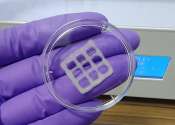All that glitters is... slimy? Gold nanoparticles measure the stickiness of snot
Some people might consider mucus an icky bodily secretion best left wrapped in a tissue, but to a group of researchers from the University of North Carolina at Chapel Hill, snot is an endlessly fascinating subject. The team ...







